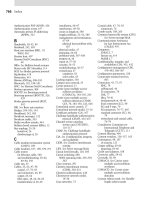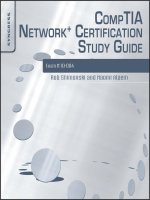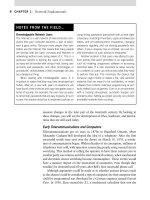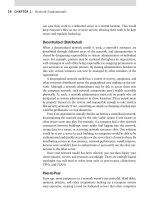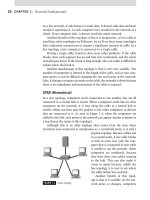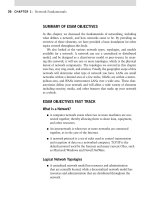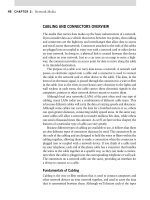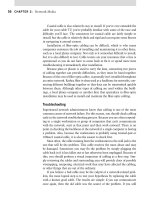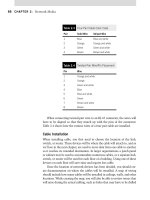CompTIA Network+ Certification Study Guide part 39 pot
Bạn đang xem bản rút gọn của tài liệu. Xem và tải ngay bản đầy đủ của tài liệu tại đây (182.47 KB, 10 trang )
366 CHAPTER 8: Wide Area Networking
today and still must be supported. Many companies and other institutions
using Frame Relay have no need at this time to upgrade their networks and
will continue to use Frame Relay until they do need to migrate to another
technology. In any case, much like X.25, Frame Relay is becoming a less fre-
quently used technology. Frame Relay is still covered directly as an objective
in the 2009 Network+ exam.
MPLS
MPLS is a new WAN technology that is becoming very popular because of
its many benefits, including its pure Layer 3 design and the fact that it is
IP-based. Furthermore, MPLS allows you to label data to have a specific pri-
ority based on the application type. The quality of service (QoS) mechanisms
in MPLS are quite sophisticated. MPLS is able to use labels to mark packets
as they come in and out of the MPLS network. When the packets enter the
MPLS network fabric, it is quickly routed to its destination based on its label
and what that label specifies. MPLS operates at Layer 3 of the OSI model and
is an excellent choice for voice and video applications. RFC 3031 (www.faqs
.org/rfcs/rfc3031.html) shows many fine details on the inner workings of the
technology and how MPLS operates.
X.25
At one time, X.25 was a popular standard for packet-switching networks,
but new installations are few and far between these days. Heavily used at
one time, it is now slowly fading away. X.25 is a WAN protocol that operates
at Layers 1, 2, and 3 of the OSI model. X.25 is very versatile, designed to
operate in almost any environment. It was not as fast as other technologies
but added a very robust error-checking mechanism that virtually guaranteed
error-free delivery of data. When network communications were carried on
much poorer network media than we enjoy today, this was a very important
protocol for WAN transmission. You can see an example of an X.25 WAN
in Figure 8.4.
Although X.25 is a fading technology and not used very often any-
more, the terminology that stems from it is, in fact, still widely in use. For
instance, when viewing Figure 8.3, you will see terminology in use such
as packet-switching exchange (PSE), customer premises equipment (CPE),
and data circuit-terminating equipment (DCE). When looking at an X.25
network, you will see that it is primarily made up of these three groupings:
data terminal equipment (DTE), DCEs, and PSEs. The PSE is no different
than the networks we talked about earlier – X.25 is a packet-switched type
of network. The X.25 WAN switches facilitate the transfer within the car-
rier’s network; this is essentially the PSE.
WAN Protocols and Properties 367
DTE devices are systems on your network that are not related to the
WAN; DTEs are usually PCs, terminals, or other hosts found on your local
network. DTE is not the responsibility of the carrier; however, DCEs usu-
ally are. DCE devices are communication devices, such as modems and
channel service units/data service units (CSUs/DSUs), that provide the
interface between DTE devices and a PSE, and are normally located within
the carriers’ network, or can be onsite at the customer’s premises, although
the carrier still maintains responsibility for the device.
As you can see, the terminology used for X.25 is used interchangeably
with other network technologies. CSUs/DSUs, modems, PCs, terminals,
and WAN-based packet switches are all common devices found when
describing most WAN technologies found in use today.
Synchronous Optical Network
Synchronous Optical Network (SONET) is an older, extremely high-speed
network that provides a standard interface for communication carriers to
connect networks based on fiber-optic cable. The SONET system uses fiber
in dual counter-rotating rings. SONET is designed to handle multiple data
types such as voice and video. The SONET standard defines a hierarchy of
interface rates that allow data streams at different rates to be multiplexed
(as shown in Table 8.1). SONET establishes OCx levels from 51.8 Mbps to
40 Gbps. OCx is short for Optical Carrier <number>. The number denotes
FIGURE 8.4
An X.25 Wide Area
Network.
Customer Premise Equipment
CPE
Modem A
Modem B
Modem C
Data Circuit Equipment
DCE
CARRIER NETWORK
X.25 WAN SWITCHES
PSE
368 CHAPTER 8: Wide Area Networking
the level of speed that comes with that level of Optical Carrier. The base rate
of OC-1 is 51.84 Mbps.
INTERNET ACCESS METHODS
In this section, we look at Internet access technologies such as DSL, cable, plain
old telephone service (POTS)/public-switched telephone network (PSTN), satel-
lites, and wireless.
DSL
DSL is commonly seen as xDSL, where the x specifies what type of DSL is in
use. DSL is commonly used to access the Internet from both residential and
business locations to provide high-speed access to the Internet. DSL became
very popular as dial-up technologies became increasingly unable to meet the
demand for fast access to the Internet.
Downloading MP3s, video files, and pictures has pretty much stretched
the limitations (and life span) of dial-up to its very limits. DSL (and other
high-speed technologies) are slowly displacing dial-up service to the Inter-
net. DSL is one of the most highly used because it can use preexisting phone
lines in your home, so installation is a bit cheaper and less intrusive.
One benefit of DSL is that it is not a shared medium, unlike cable net-
works, which use shared access. Shared access means that when there is
heavy usage of the system, less bandwidth is available to individual users.
DSL is a dedicated bandwidth, so the only one using that bandwidth is you.
One drawback of DSL, however, is that the QoS is dependent on the
user’s distance from the central office (CO). The CO is where the network
endpoint is located and is generally run by your ISP. The farther you are from
Table 8.1
Optical Carrier Levels and Data Transmission Rates
Optical Carrier Level Data Transmission Rate
OC-1 51.84 Mbps
OC-3 155.52 Mbps
OC-12 622.08 Mbps
OC-24 1.244 Gbps
OC-48 2.488 Gbps
OC-192 10 Gbps
OC-256 13.271 Gbps
OC-768 40 Gbps
Internet Access Methods 369
the CO, the worse (slower) the service is. There are many forms of DSL. The
most common forms of DSL are asymmetric DSL (ADSL) and symmetric
DSL (SDSL).
ADSL
ADSL is the most widely deployed form of DSL technology. Most homes and
small businesses currently using DSL technology use ADSL. ADSL is used
to transmit digital information on preexisting phone lines. Although using
the phone lines, it is still much quicker than dial-up, so don’t be fooled. Also,
unlike dial-up, ADSL provides an always on connection to the Internet.
ADSL is also able to place voice and data information on the same line.
The main design feature of ADSL is that it is asymmetric. This means
that ADSL is designed to provide more bandwidth in one direction than in
the other. The reason for this is quite practical; think of how much data
you download from the Internet (every time you access a Web page, you are
downloading). For most users, the amount of information that is uploaded
is minimal, so in ADSL, bandwidth is allocated where it’s needed (on the
downstream channel). ADSL generates downstream speeds of approxi-
mately 8 Mbps and upstream speeds of up to 640 Kbps.
SDSL
SDSL is typically used in larger companies, and the upstream and down-
stream channels are of the same size; that is, the download speed and upload
speed are equal. SDSL operates at approximately 2 to 2.5 Mbps.
Exam Warning
Other forms of DSL not covered by the exam, but worth researching, are very high-speed
digital subscriber line (VDSL), high-speed digital subscriber line (HDSL), symmetrical
high-speed digital line subscriber (SHDSL), ISDN digital subscriber line (IDSL), and
second-generation HDSL (HDSL-2). You will have to be familiar with ADSL and SDSL not
only for the exam but also for your own use if you plan on working on DSL. These are the
most commonly used types and will surely be something you want to know about in more
depth if the situation arises where you may be working with this technology. For the exam,
you need to know how to troubleshoot problems with DSL, although DSL itself may not be
the problem. Look for misleading types of questions that ask you about DSL technology,
although the questions are not essentially focused on that particular technology. The
Network+ exam is notorious for these types of scenario questions. Be able to isolate what
the cause of a problem may be, whether it may be an ISDN, a DSL, or a Wireless ISP
(WISP) connection based on the technology and the underlying network – as well as prob-
lems may also be occurring there that are misleading you into the wrong answer. Finally,
make sure that you remember that DSL and ISDN are both digital technologies, not analog.
370 CHAPTER 8: Wide Area Networking
Cable Modem
Broadband cable access requires the use of a modem designed to operate
over cable TV lines. Because the coaxial cable used by cable TV provides
much greater bandwidth than telephone lines, a cable modem can be used
to achieve extremely fast access to the World Wide Web (WWW). Cable
modems are commonly used in small and home offices. Figure 8.5 shows a
typical cable network setup.
Many cable providers are working diligently to provide the best access at
the lowest cost and to be less intrusive into your home or office. Cable net-
works provide a shared access to the users on the network, so heavy usage
can slow it down, unlike DSL, which has dedicated user access. However,
DSL has generally slower upload speeds than download speeds, unlike cable
networks. Because cable networks do not use preexisting phone lines in
the home, cable companies will have to install a line into your home (at an
additional cost) if one doesn’t already exist.
Cable networks provide speeds up to approximately 10 Mbps, which is
much faster than ADSL, which usually ranges from 64 to 256 Kbps. Even
with shared access, cable is often faster at most times. As the ISP’s networks
get cluttered, normally scheduled upgrades to the network will usually be
conducted to solve those issues as they occur, or most times, proactively
FIGURE 8.5
A Typical Cable Network.
Internet Access Methods 371
As mentioned before, the speeds
for dial-up are not very fast (dial-up
does not provide speeds above
56 Kbps). Try not to get confused
between ISDN and dial-up. Both use
dialing, but dial-up is based on the
telephone system and uses analog
lines, whereas ISDN and DSL are
both digital. For the Network+
exam, you will need to have a clear
picture of each technology and its
basics, and you must be able to dif-
ferentiate between them.
Exam Warning
Some of the most common questions that you are likely to have to solve will be in the
form of how to troubleshoot network devices or which one is better and faster than the
other. Which one should you use and for what reasons? Refer to Chapters 11 and 12,
which discuss how to troubleshoot networking devices.
Note
A few notes about Table 8.2: first, bis means second edition. Also, theoretically, an analog
telephone line has a maximum speed of approximately 35 Kbps, so you can consider the
V.90 modem to be the fastest, and since it can only receive, it’s a pretty good assumption
that dial-up Internet access is going to be slow (in the Kbps range) and any faster speeds
can only be reached by using other methods of Internet access such as DSL or cable.
before they occur. Unfortunately, cable networks are not available everywhere
yet. DSL has more availability at this time than cable networks.
POTS/PSTN
The PSTN refers to the international telephone system based on copper wires
carrying analog voice data. Telephone service carried by the PSTN is often
called POTS, which refers to the standard telephone service that most homes
use. When referring to either, we are generally referring to dial-up technolo-
gies where you would use a dial-up modem to connect to your ISP to get to
the Internet. In Figure 8.6, you can see a standard dial-up session taking place
so that a user can access the Internet through the telephone carrier’s network
from within his home. Refer to Table 8.2 for typical dial-modem speeds.
FIGURE 8.6 Dialing up to the Internet.
INTERNET
PSTN
PC with Modem PCI Card
372 CHAPTER 8: Wide Area Networking
Wireless
WISPs provide Internet access anywhere that it has coverage. Many loca-
tions that have very little access to a good last mile source use this technol-
ogy to connect to the Internet. Homes also use this very often to get Internet
access. You can access the Internet from an antenna in your local PC, no
matter where you are, as long as you can access an antenna and have a clear
shot to the antenna you want to connect with. We will look at the most
commonly used ways to access the Internet with a wireless connection later
in this chapter. Wireless is also covered extensively in Chapter 5, “Wireless
Networking”.
Wireless Wide Area Network
Wireless technology has witnessed dramatic improvements recently. Wir-
eless wide area networks (WWANs) are network traffic encapsulated in
mobile communications technology such as Worldwide Interoperability for
Microwave Access (WIMAX), Universal Mobile Telephone Service (UMTS),
code division multiple access (CDMA) 2000, or 3G networks to name just
a few. The Mobile Telecommunication Cellular Network allows users with
WWAN cards or built-in cellular radios (Global Systems for Mobile com-
munications/CDMA) to surf the Web, send and receive e-mail, and in gen-
eral perform any networking function as if physically connected to a WAN.
Because of the nature of this technology, distances are not as great a factor
as they are in physical networks; however, transmission rates are greatly
reduced when compared to physical connections.
WIMAX is based on IEEE 802.16 standards, or Broadband Wireless
Access. An acceptable rule of thumb is that WIMAX will sustain 70 Mbps
transmission rates at approximately 30 miles. This is only a rule of thumb
because of signal degradation. As distance increases, throughput decreases
and vice versa. Competition for access point connectivity is reduced
through scheduling in that once the WIMAX device connects to the access
Table 8.2
Typical Dial-Up Modem Speeds
Modem Speed
V.90 56 Kbps (receive only)
V.34 33.6 Kbps
V.32 bis 14.4 Kbps
Internet Access Methods 373
point, it is assigned a set time to communicate with the access point from
then on.
Satellite
Satellite dishes are starting to gain popularity as a way to access the Internet.
Many times (as is the case with cable), your carrier or ISP will provide you
with television service, or some other form of service, so you can use the
satellite dish for multiple purposes. Also, the dish is less intrusive into your
home because it’s mounted with very little need for wires or a run to a CO.
Satellite is becoming a very convenient way to connect to the Internet with-
out having any wires run into your home.
Mobile and remote users (users who travel often and usually use a laptop)
are starting to use satellite to access the Internet more frequently. These
mobile users want to link their laptops to the Internet no matter where they
are located. If you sign up with an ISP that uses satellite to provide Internet
access, then you will be able to work through them to get the coverage plan
you need.
A typical satellite-based network is shown in
Figure 8.7. A satellite is used to allow a user with
a laptop, personal digital assistant (PDA), or PC
with wireless satellite capabilities to connect to
the Internet from anywhere within the coverage
area. Figure 8.7 shows the use of low Earth orbit
satellites (LEOs) and medium Earth orbit satel-
lites (MEOs).
LEOs are primarily used with Internet-based
satellite communications and are typically located
approximately 1,800 to 2,000 miles above Earth.
MEOs orbit at approximately 9,000 to 10,000
miles above Earth. There are also geosynchronous
Earth orbits (GEOs), which are typically used for
the carrier’s or ISP’s trunk lines. GEOs orbit at
approximately 22,000 to 23,000 miles above
Earth. All play an essential role in allowing you
to access the Internet from just about anywhere
in the world.
While satellite communications are often
costly and slow, the ease of use and flexibility of
wireless communications are always the same –
FIGURE 8.7 A Satellite-Based Network.
Satellite (MEO)
Satellite (LEO)
PDA
User with PDA and Antenna
User
374 CHAPTER 8: Wide Area Networking
slower, more costly, but flexible in use. Wireless systems and satellites are
commonly used in geographical areas that are far from a CO or when extreme
flexibility is needed.
SUMMARY OF EXAM OBJECTIVES
In this chapter, we covered the Network+ exam objectives based around
WAN technologies such as packet switching, which is the always-on type
of network, and circuit switching, which is a type of network that has to be
created each time it is used (such as ISDN). We also covered the fundamen-
tals of ISDN, which is a digital method of transmitting data across copper
telephone lines, using service provider ID numbers to connect the network
(circuit-switched) for sending and receiving of data. We covered the funda-
mentals of Frame Relay, MPLS, X.25, and SONET as well as T- and E-level
carrier lines.
We discussed the primary ways to get Internet access, such as with
DSL. DSL is a digital method of transmitting data over preexisting cop-
per telephone lines. ADSL is a technology that allows for faster down-
load speeds. DSL speeds also vary depending on how far from the CO
you are. Cable-based ISPs were also covered, which is generally faster
than DSL, but can also become congested if too many subscribers use the
shared media all at once. Both are far better when it comes to speed and
use than POTS or PSTN. The dial-up method of access using a standard
modem is the slowest method of access. Satellite and WWAN technolo-
gies were also discussed; they afford you the flexibility of use over speed
and security.
EXAM OBJECTIVES FAST TRACK
Switching Methods
Packet-switching technologies are always available, but circuit
switching is not.
Circuit switching requires a separate setup for each connection
session.
Packet switching is the method of sending data from location to
location on a WAN that is always available. There is no need to
initiate a call to a WAN switch, as the connection is already up and
running from the start.
Exam Objectives Frequently Asked Questions 375
WAN Protocols and Properties
The name T denotes the type of line it is, a dedicated media con-
nection supporting data rates of 1.544 Mbps, where compared with
E1 carries a signal up to 2 Mbps.
ISDN uses a call-initiated and call-terminated signal, which sup-
ports data rate of 64 Kbps per channel.
FDDI provides very high-speed connectivity, which is based on a
fiber ring with 100 Mbps dual-ring token-passing technology.
Frame Relay has a high transmission speed and is a packet-switching
protocol that supports data transfer rates at T1 and T3.
Internet Access Methods
DSL is common to find at home or in businesses to provide high-
speed access to the Internet and is broken up in two categories,
ADSL and SDSL.
Cable modems usually provide home users with broadband access
to operate cable TV, phone line, and Internet access.
POTS and PSTN generally refer to dial-up technologies used to dial
into a network like an ISP to gain access to the Internet.
WISPs provide access to the Internet via an antenna on your
personal computer where the antenna connects wirelessly to the
access point.
WWANs use mobile communications like WIMAX, UMTS,
CDMA2000, or 3G to access the Internet.
Satellites are used to access the Internet by users who want the
ability to have coverage anywhere in the world.
EXAM OBJECTIVES FREQUENTLY ASKED QUESTIONS
Under what conditions should I use packet switching as compared Q:
to circuit switching?
When you have users who need to be connected at any given A:
moment you are going to want to use packet switching because
this method allows for a constant connection to the desired net-
work your users need access to.
